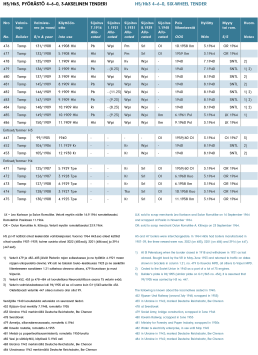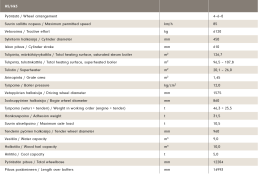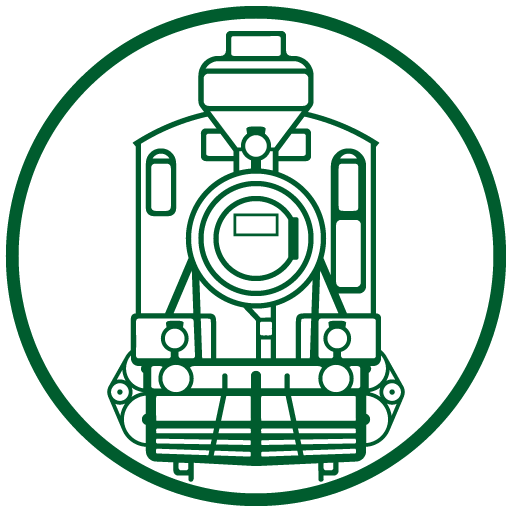H5 nro 479 Tampereen Pellava- ja Rautateollisuus Osakeyhtiön perinteisessä veturien valokuvauspaikassa tehtaan alueella. Tästä paikasta lähdettiin usein koeajolle ennen veturin luovutusta Valtionrautateille.
4–6–0 no. 479 was photographed in 1909 at the familiar location outside the locomotive workshops at Tampereen Pellava- ja Rautateollisuus Oy. Many a test run started off from this point prior to a locomotive being handed over to SVR.
Kuva Tampella 1909, kokoelma Matti Bergström / Photo Tampella, Matti Bergström collection
Vuonna 1918 Venäjälle jääneitä vetureita ostettiin takaisin Suomeen vuonna 1923. Kuvassa etumaisena H5-sarjan veturi nro 483 Rajajoella syyskuun 1923 vastaanottotarkastuksessa.
Certain locomotives remained beyond the Russia frontier in 1918 but were redeemed in 1923. Here H5 no. 483 is being inspected before acceptance at the Rajajoki border station in September 1923.
Kokoelma Olavi Kilpiö / Olavi Kilpiö collection
Tulistinkattilalla varustetusta I3-paikallisliikenneveturista 456 välittömästi saadut myönteiset kokemukset johtivat tulistinkattilan käyttöönottoon myös henkilöliikennevetureissa. Tampellalta tilattiin 1907 kahdessa erässä 11 veturia, jotka saivat sarjamerkin H5 ja numerot 476–486. Sarja H5 kasvoi myöhemmin kolmella entisellä H3:lla ja viidellä entisellä H4:llä. Vuonna 1942 jäljellä olleet H5-veturit saivat sarjatunnuksen Hk3.
Erona H4-sarjaan H5:ssä oli tulistinkattila ja kaksoiskoneisto sekä alkujaan suuremmat sylinterit. Muutoin rakenne oli sama eli levykehys, mäntäluistit, Stephensonin sisäpuoliset luistikoneistot ja kolmiakselinen tenderi. Vetureissa oli Aga-valaistus ja alkujaan halkolämmitys, jota muutettiin hiilille ja takaisin haloille aina tarpeen mukaan.
H5-kehyksiä jouduttiin paikkaamaan ja vahvistamaan useasti, kunnes sarjalle valmistettiin vahvemmat kehykset ja vetoakselit vuosina 1927–34. Jälkimmäisenä vuonna veturien suurinta sallittua nopeutta korotettiin 85 km:iin/h. Muita näkyviä muutoksia oli osittainen siirtyminen sähkövalaistukseen vuodesta 1935 alkaen ja aiemman kehystenvaihdon yhteydessä toteutetut varusteiden sijoitusmuutokset, kuten pääilmasäiliön siirto veturin etupäähän. Kylälän lietsointa kokeiltiin veturissa 481 vuonna 1918.
H1–H5-sarjat hankittiin korvaamaan vanhat A-sarjat nopeasta matkustajajunaliikenteestä. H5-veturit siirrettiin aluksi Helsinkiin, josta ne siirtyivät Viipuriin ja Pietariin. Ensimmäisen maailmansodan sytyttyä sarjaa siirrettiin lännemmäksi Helsinki–Tampere–Turku-alueelle. Kuitenkin veturit 479 ja 482–485 jäivät rajan sulkeutuessa Venäjälle. Sieltä ne ostettiin takaisin 1923. Vuonna 1940 Neuvostoliitolle luovutettiin sotakorvauksina veturit 478–484 sekä alkujaan H3-sarjasta muutetut veturit 452 ja 453.
H5-sarja syrjäytyi tärkeimmistä pääratojen matkustajaliikenteen tehtävistä H8–H9-sarjojen tullessa liikenteeseen. Sitä käytettiin henkilöjunissa Turun, Tampereen, Karjaan ja Viipurin varikoilta sekä pika- että henkilöjunissa kevytrakenteisilla haararadoilla Pieksämäen, Iisalmen ja Sortavalan varikoilla. Sarja sijoitettiin Joensuuhun ja Ouluun 1940-luvulla ja kymmenisen vuotta myöhemmin Pieksämäelle ja Iisalmeen. Sodan jälkeen Hk3-veturit työskentelivät pääasiassa Itä- ja Pohjois-Suomessa. Sarjan viimeiset junavuorot ajettiin linjoilla Kuopio–Kontiomäki vuonna 1958 ja Helsinki–Porvoo 1960. Monilukuiset Dm6- ja Dm7-kiskobussit syrjäyttivät henkilöliikenteen kevyet höyryveturisarjat ja muutaman seisontavuoden jälkeen kaikki Hk3-veturit hylättiin vuonna 1964.
The trials with class I3 2–6–4T no. 456 in 1906 demonstrated the advantages of superheating, leading to the general adoption of the superheater for new main line SVR engines. An order therefore followed in 1907 for Tampella to build eleven superheated passenger locomotives to be delivered in two batches in the following couple of years. These were classified H5 and numbered 476–486.
The decision was made in 1923 to rebuild and superheat the H4s in accordance with the H5 class; the modified H4 engines (nos. 471–475) were then also classified H5. Other locomotives to receive the class H5 designation were the three H3 engines rebuilt with larger H5 boilers: nos. 452–453 in 1929–31 and no. 447 in 1940. All of these engines became the Hk3 class under the revised classification programme of 1942.
The six-coupled H5 engines had a pivoted, swinging bogie. They had plate frames and used piston valves with Stephenson inside valve gear. Aga lighting was used for the engine lamps. Built as wood burners, they had six-wheel tenders. Later, the whole class was periodically coal fired.
The H5 locomotives were provided with strengthened frames and stronger driving axles between 1927 and 1934 following recurring patching and welding repairs. Fittings for the boiler and the engine were exchanged for modern components. A prominent change was the main air reservoir situated behind the front buffer beam. Nos. 452 and 453 in 1930 and no. 447 in 1940 had their crank pins strengthened. The maximum permitted speed was raised to 85km/h in 1934. Electric lighting equipment was fitted after 1935. A Kylälä blast pipe was tested on no. 481 in 1918.
The H1–H5 classes were acquired to replace the old A classes on express and semi-fast passenger services. Nos. 476–486 were allocated to Helsinki but the majority were transferred to Viipuri and St Petersburg within a few years. Following the outbreak of the First World War, the engines in the east of Finland were moved to depots in the Turku–Tampere–Helsinki triangle in southern Finland. H5s nos. 479 and 482–485 were left on Russian territory in 1918 but were repatriated in 1923. Nos. 452–453 and 478–484 were ceded as war reparations to the Soviet Union in 1940.
The H5 class was eventually demoted from the important main line passenger rosters by the H8 and H9 classes, and placed on secondary passenger duties at Turku, Tampere, Karjaa, Kouvola and Viipuri, or hauling express and passenger trains on the lightly constructed branch lines from Pieksämäki, Iisalmi and Sortavala. The class was based at Joensuu and Oulu in the 1940s but were to be found at Pieksämäki and Iisalmi a decade later. The final Hk3 duties were on Kuopio–Kontiomäki and Helsinki–Porvoo turns in 1958 and 1960 respectively. The numerous Dm6 and Dm7 railcars put an end to lightly loaded steam hauled trains and, after a few years in store, all the Hk3s were withdrawn in 1964.








